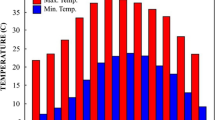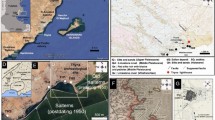Abstract
The Dasari beach-dune system fronted by an intertidal mud flat is a typical example of numerous small beaches found both in embayments and along the open macrotidal west coast of Korea. The beach is frequently exposed to energetic wave action at high tide in winter. Although this coastal dune-sandy beach-intertidal mud flat system has previously been described, its origin and morphodynamic behavior has to date not been firmly established. To clarify these issues, elevation profiles and surficial sediment samples were collected seasonally along five monitoring transects across the tidal flat. In addition, box-cores as well as vibro- and drill-cores were acquired along the middle transect. Optically stimulated luminescence (OSL) and 14C– AMS (accelerator mass spectrometry) dating methods were applied to determine the age of the tidal flat, the beach and the dune deposits. The results show that Dasari beach is topographically composed of two distinct morphological and sedimentological sectors, comprising a high-tide sandy beach that merges seaward into an extensive low-tide tidal flat composed of mud. The transition between the two sectors is marked by a sharp break in slope and change in internal sedimentary structures. At the boundary, the subtle shoreward fining trend in mean grain size on the intertidal flat switches to a pronounced shoreward coarsening trend. Near the transition, mixing between the beach sand and the mud is observed. Another striking feature is a seasonal rotation of the beach system centered on the middle sector, with the northern sector eroding in winter and accreting in summer, and the southern sector accreting in winter and eroding in summer. The spatial grain-size pattern reveals that the beach is fed from the neighboring beach in the north by lateral headland bypassing, rather than onshore transport across the tidal flat, the intermittent lateral supply of sand explaining the seasonal rotation of the beach. Stratigraphically, the beach-dune deposits are underlain by muddy tidal flat deposits, which results in a clear upward coarsening grain-size trend and thus intimates transgressive deposition associated with sea-level rise over the past 7–8 ka. However, a time gap of 4–5 thousand years between the tidal flat and the beach-dune deposits indicates that there is no genetic link between the two depositional systems. As the modern beach-dune system is remote from the former landward limit of the tidal flat, a continuous retreat model must be rejected. Instead, a lateral headland bypassing model, in which sand supplied alongshore progressively encroached the tidal flat, is more plausible. In the light of this interpretation, many of the barrier beach-lagoon models proposed for the macrotidal west coast of Korea need to be reconsidered.









Similar content being viewed by others
References
Anthony EJ, Dolique F (2004) The influence of Amazon-derived mud banks on the morphology of sandy headland-bounded beaches in Cayenne, French Guiana: a short- to long-term perspective. Mar Geol 208:249–264
Anthony EJ, Gardel A, Dolique F, Guiral D (2002) Short-term changes in the plan shape of a sandy beach in response to sheltering by a nearshore mud bank, Cayenne, French Guiana. Earth Surf Process Landf 27:857–866
Anthony EJ, Gardel A, Gratiot N, Proisy C, Allison MA, Dolique F, Fromard F (2010) The Amazon-influenced muddy coast of South America: a review of mud-bank-shoreline interactions. Earth-Sci Rev 103:99–121
Anthony EJ, Gardel A, Dolique F, Brunier G, Peron C (2015) Mud banks, sand flux and beach morphodynamics: Montjoly Lagoon beach, French Guiana. In: Maanan M, Robin M (eds) Sediment fluxes in coastal areas. Coastal Research Library, vol 10, p 75–90
Carver RE (1971) Procedures in sedimentary petrology. Wiley-Interscience, New York
Chang TS, Kim JC, Yi S (2014) Discovery of Eemian marine deposits along the Baeksu tidal shore, southwest coast of Korea. Quat Int 349:409–418
Chang TS, Ha HJ, Hong SH (2016) Mud deposition on a macrotidal beach: Dasari coastal dune, west coast of Korea. J Coast Res SI 75:1312–1316
Choi J-H, Murray AS, Jain M, Cheong C-S, Chang HW (2003) Luminescence dating of well-sorted marine terrace sediments on the southeastern coast of Korea. Quat Sci Rev 22:407–421
Choi KH, Chang TS, Choi J-H, Kim Y, Lee SY (2014) Burial storm deposits recorded at the coastal dunes, Dasari, Chungnam Province. J Geol Soc Korea 50:539–549
Chough SK, Lee HJ, Chun SS, Shinn YJ (2004) Depositional processes of late Quaternary sediments in the Yellow Sea: a review. Geosci J 8:211–264
Flemming BW (1988) Processes and pattern of sediment mixing in a microtidal coastal lagoon along the west coast of South Africa. In: De Boer PL, Van Gelder A, Nio SD (eds) Tide-influenced sedimentary environments and facies. D Reidel, Dordrecht, pp 275–288
Flemming BW (2002) Geographic distribution of muddy coasts. In: Healy TR, Wang Y, Healy J-A (eds) Muddy coasts of the world: Processes, deposits and function. Elsevier Science, Amsterdam, pp 99–201
Flemming BW (2005) Tidal environments. In: Schwartz M (ed) Encyclopedia of Coastal Science. Springer, Berlin, pp 1180–1185
Flemming BW (2012) Siliciclastic back-barrier tidal flats. In: Davis RA Jr, Dalrymple RW (eds) Principles of tidal sedimentology. Springer, Dordrecht, pp 231–267
Folk RL (1966) A review of grain-size parameters. Sedimentology 6:73–93
Folk RL, Ward WC (1957) Brazos River bar: a study in the significance of grain size parameters. J Sediment Petrol 27:3–26
Gratiot N, Gardel A, Anthony EJ (2007) Trade-wind waves and mud dynamics on the French Guiana coast, South America: input from ERA-40 wave data and field investigation. Mar Geol 236:15–26
Gratiot N, Anthony EJ, Gardel A, Gaucherel C, Proisy C, Wells JT (2008) Significant contribution of the 18.6 year tidal cycle to regional coastal changes. Nat Geosci 1:169–172
Hawley N (1982) Intertidal sedimentary structures on a macrotidal beach. J Sediment Petrol 52:785–796
Hayes MO (1979) Barrier island morphology as a function of tidal and wave regime. In: Leatherman SP (ed) Barrier islands. Academic Press, New York, pp 1–27
Jago CF, Hardisty J (1984) Sedimentology and morphodynamics of a macrotidal beach, Pendine Sands, SW Wales. Mar Geol 60:123–154
Kim YH, Lee HJ, Chun SS, Han SJ, Chough SK (1999) Holocene transgressive stratigraphy of a macrotidal flat in the southeastern Yellow Sea: Gomso Bay, Korea. J Sediment Res 69:328–337
Kim TI, Choi BH, Lee SW (2006) Hydrodynamics and sedimentation induced by large-scale coastal developments in the Keum River Estuary, Korea. Estuar Coast Shelf Sci 68:515–528
Lee CB (1977) Sedimentological properties of the recent coastal sand dunes, located in Biin area, west coast of Korea. MSc thesis, Seoul National University, Korea
Lee HJ (2014) A review of sediment dynamical processes in the west coast of Korea, eastern Yellow Sea. Ocean Sci J 49:85–95
Levoy F, Anthony EJ, Monfort O, Larsonneur C (2000) The morphodynamics of megatidal beaches in Normandy, France. Mar Geol 171:39–59
Masselink G, Hegge B (1995) Morphodynamics of meso- and macrotidal beaches: examples from central Queensland, Australia. Mar Geol 129:1–23
Masselink G, Short AD (1993) The effect of tide range on beach morphodynamics and morphology: a conceptual beach model. J Coast Res 9:785–800
Masselink G, Austin M, Tinker J, O’Hare T, Russell R (2008) Cross-shore sediment transport and morphological response on a macrotidal beach with intertidal bar morphology, Truc Vert, France. Mar Geol 251:141–155
McCave IN, Geiser AC (1979) Megaripples, ridges and runnels on intertidal flats of the Wash, England. Sedimentology 26:353–370
Morio I, Sedrati M, Goubert E, Floc’h F, Furgerot L, Garlan T (2016) Morphodynamic of a sandy-muddy macrotidal estuarine beach under contrasted energy conditions (Vilaine estuary, France). J Coast Res SI 75:258–262
Murray AS, Wintle AG (2000) Luminescence dating of quartz using an improved single-aliquot regenerative-dose protocol. Radiat Meas 32:57–73
Sedrati M, Anthony EJ (2007) Storm-generated morphological change and longshore sand transport in the intertidal zone of a multi-barred macrotidal beach. Mar Geol 244:209–229
Short AD (1991) Macro-meso tidal beach morphodynamics - an overview. J Coast Res 7:417–436
Short AD (2006) Australian beach systems-nature and distribution. J Coast Res 22:11–27
Short AD, Woodroffe CD (2009) The coast of Australia. Cambridge University Press, Cambridge
Stuiver M, Reimer PJ, Reimer R (2015) CALIB radiocarbon calibration program revision 7.1. http://calib.qub.ac.uk/calib/
Wright LD, Nielsen P, Short AD, Green MO (1982) Morphodynamics of a macrotidal beach. Mar Geol 50:97–128
Yang BC, Dalrymple RW, Chun SS, Lee HJ (2006) Transgressive sedimentation and stratigraphic evolution of a wave-dominated macrotidal coast, western Korea. Mar Geol 235:35–48
Yang DY, Kim JY, Han M (2016) Study on formation processes of coastal dunes around Sangha area, Gochang (in Korean). KIGAM research report (unpublished), p 21–54
Acknowledgements
This study was supported by a research grant from the Korean Ministry of Oceans and Fisheries (PJT200538). We are grateful to the journal editor, Burg W. Flemming, for his assessment and language corrections of an earlier draft, and to two peer-reviewers, Dr. B.C. Yang (KNOC) and Prof. A. Short (University of Sydney), for constructive comments. Special thanks are due to Prof. A. Short for providing related literature and comments at an earlier stage of this study.
Author information
Authors and Affiliations
Corresponding author
Ethics declarations
Conflict of interest
The authors declare that there is no conflict of interest with third parties.
Additional information
Responsible guest editor: R.A. Scasso
Rights and permissions
About this article
Cite this article
Chang, T.S., Hong, S.H., Chun, S.S. et al. Age and morphodynamics of a sandy beach fronted by a macrotidal mud flat along the west coast of Korea: a lateral headland bypass model for beach-dune formation. Geo-Mar Lett 37, 361–371 (2017). https://doi.org/10.1007/s00367-016-0486-y
Received:
Accepted:
Published:
Issue Date:
DOI: https://doi.org/10.1007/s00367-016-0486-y




